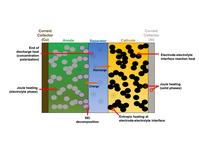Heat Generation and Thermal Transport in Lithium-Ion Batteries: A Scale-Bridging Perspective
Heat Generation and Thermal Transport in Lithium-Ion Batteries: A Scale-Bridging Perspective
| Event Date: | February 7, 2019 |
|---|---|
| Authors: | R. Kantharaj and A. Marconnet |
| Paper URL: | Link to Full Text |
Lithium-ion batteries are complex, heterogeneous systems with coupled electrochemical and thermal phenomena that lead to elevated temperatures, which, in turn, limit safety, reliability, and performance. Despite years of research, there are still open questions about the electrochemical-thermal phenomena within battery cells. This article highlights recent advances in thermal characterization and modeling of lithium-ion batteries with an emphasis on the multi-scale aspect of battery systems: from the microscale electrode components to the macroscale battery packs. Both heat generation and thermal properties (thermal conductivity and specific heat capacity) are impacted by battery capacity, charge/discharge rate, ambient conditions, and the underlying microstructure. Understanding thermal phenomena and designing batteries to prevent thermal runaway requires multiscale efforts from the microstructure of the electrodes to the overall system behavior. Experimental efforts have focused on both property and performance characterization, as well as development of new battery chemistries for improved performance and new designs for improved thermal management. Past numerical modeling work ranges from computationally efficient lumped approaches to high fidelity microstructural finite element models. Ultimately, coupled electrochemical-thermal investigations (both numerical and experimental) are required to further improve the performance and reliability of batteries, and to prevent thermal runaway. This perspective article provides insight into directions to improve these approaches with the goal of informing design of batteries with improved performance, safety, and reliability.

